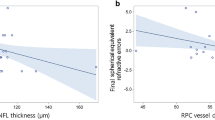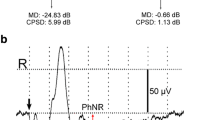Abstract
Ametropias, particularly myopia, and mild retinal dysfunction are found in eyes with a history of retinopathy of prematurity. The retina is an important controller of refractive development. The aims of this study were to find out whether altered measures of retinal function and ametropias are associated and to consider mechanisms by which the retina might control refractive development. Nine infants and children with a history of stage 1, 2 or 3 retinopathy of prematurity and known courses of refractive development were studied. Spherical equivalents at the time of the electroretinogram ranged from +5.50 to −9.00 diopters. Rod photoresponse characteristics were derived from the a-wave, and postreceptoral components were also analyzed with calculation of the sensitivity and saturated amplitude of the b-wave, the sensitivity of oscillatory wavelet OP2, and average amplitudes of OP3 and OP4. In hyperopic and myopic patients alike, the saturated amplitude and gain of the rod cell response were attenuated. In all patients, b-wave sensitivity was low, but in most there was little effect on saturated b-wave amplitude. In patients with courses toward myopia, the amplitude of OP4, an ‘OFF’ signal, is relatively more attenuated than that of OP3, an ‘ON’ signal. OP4 is relatively larger in patients with courses toward hyperopia. The OP results suggest that an imbalance of ‘ON’ and ‘OFF’ activity in the retina is associated with development of ametropias in retinopathy of prematurity.
Similar content being viewed by others
Abbreviations
- ROP:
-
retinopathy of prematurity
References
Fulton AB, Hansen RM, Petersen RA. ERG responses in patients with a history of retinopathy of prematurity (ROP). Invest Ophthalmol Vis Sci 1995; 36(suppl): 19. Abstract.
Fulton AB, Hansen RM. Photoreceptor function in infants and children with a history of mild retinopathy of prematurity. J Opt Soc Am (A) 1996; 13: 566–571.
Reynaud X, Hansen RM, Fulton AB. The effect of prior oxygen exposure on the electroretinographic responses of infant rats. Invest Ophthalmol Vis Sci 1995; 36: 2071–9.
Quinn GE, Dobson V, Repka MX, et al. Development of myopia in infants with birth weights less than 1251 grams. Ophthalmology 1992; 99: 329–40.
Lue C-L, Hansen RM, Reisner DS, Findl O, Petersen RA, Fulton AB. The course of myopia in children with mild retinopathy of prematurity. Vision Res 1995; 5: 1329–35.
Troilo D, Gottlieb MD, Wallman J. Visual deprivation causes myopia in chicks with optic nerve section. Curr Eye Res 1987; 6: 993.
Troilo D, Judge SJ. Ocular development and visual deprivation myopia in the common marmoset (Callithrix jaccus). Vision Res 1993; 33: 1311–24.
Ehrlich D, Sattayasai J, Zappia J, Barnngton M. Effects of selective neurotoxins on eye growth in the young chick. In: Block G, Widdows K, eds. Myopia and the control of eye growth. Chichester: Wiley & Sons, 1990: 63–898.
Liang H, Crewther DP, Crewther SG, Barila AM. A role for photoreceptor outer segments in the induction of deprivation myopia. Vision Res 1995; 35: 1217–25.
Chan-Ling T, Gock B, Stone J. The effect of oxygen on vasoformative cell divisian: evidence that ‘physiological hypoxia’ is the stimulus for normal retinal vasculogenesis. Invest Ophthalmol Vis Sci 1995; 36: 1201–14.
Wallman J. Retinal control of eye growth and refraction. Prog Ret Res 1992; 12: 133–53.
Dagi LR, Leys MJ, Hansen RM, Fulton AB. Hyperopia in complicated Leber's congenital amaurosis. Arch Ophthalmol 1990; 108: 709–12.
Hill D, Arbel K, Berson E. Cone electroretinograms in congenital nyctalopia with myopia. Am J Ophthalmol 1974; 78: 127–36.
Young RSL. Low-frequency component of the photopic ERG in patients with X-linked congenital stationary night blindness. Clin Vision Sci 1991; 6: 309–15.
Sieving PA, Fishman GA. Refractive errors of retinitis pigmentosa patients. Br J Ophthalmol 1978; 62: 163–7.
Evans NM, Fielder AR, Mayer DL. Ametropia in congenital cone deficiency: a defect of emmetropization. Clin Vision Sci 1989; 4: 126–36.
Committee for the Classification of Retinopathy of Prematurity. An international classification of retinopathy of prematurity. Arch Ophthalmol 1984; 102: 130–4.
Birch DG, Fish GE. Rod ERGs in retinitis pigmentosa and cone-rod degeneration. Invest Ophthalmol Vis Sci 1987; 28: 140–50.
Fulton. AB, Hansen RM. The rod sensitivity of dark adapted human infants. Curr Eye Res 1992; 11: 1193–8.
Hansen RM, Fulton AB, Harris SJ. Background adaptation in human infants. Vision Res 1986; 26: 771–9.
Kraft TW, Schneeweis DM, Schnapf JL. Visual transduction in human rod photoreceptors. J Physiol 1993; 464: 747–65.
Hood DC, Birch DG. Rod phototransduction in retinitis pigmentosa: estimation and interpretation of parameters derived from the rod a-wave. Invest Ophthalmol Vis Sci 1994; 35: 2948–61.
Lamb TD, Pugh EN Jr. A quantitative account of the activation steps involved in phototransduction in amphibian photoreceptors. J Physiol 1992; 449: 719–58.
Fulton AB, Hansen RM, Findl O. The development of the rod photoresponse from dark adapted rats. Invest Ophthalmol Vis Sci 1995; 36: 1038–45.
Breton ME, Schueller A, Lamb TD, Pugh EN Jr. Analysis of ERG a-wave amplification and kinetics in terms of the G-protein cascade of phototransduction. Invest Ophthalmol Vis Sci 1994; 35: 295.
Findl O, Hansen RM, Fulton AB. The effects of acetazolamide on ERG responses in rats. Invest Ophthalmol Vis Sci 1995; 36: 1019–26.
Fulton. AB, Hansen RM, Yeh Y-L, Tyler CW. Temporal summation in dark adapted 10-week-old infants. Vision Res 1991; 31: 1259–69.
Fulton AB, Dodge J, Hansen RM, Schremser J-L, Williams TP. The quantity of rhodopsin in young human eyes. Curr Eye Res 1991; 10: 977–82.
Fulton AB, Hansen RM. Workup of the possibly blind child. In: Isenberg SJ, ed. The eye in infancy. 2nd ed. St. Louis: Mosby, 1994: 5470060.
Chen J-F, Elsner AE, Burns SA, et al. The effect of eye shape on retinal responses. Clin Vision Sci 1992; 7: 521–30.
Hood DC, Birch DG. A computational model of the amplitude and implicit time of the b-wave of the human ERG. Vis Neurosci 1992; 8: 107–26.
Troilo D, Wallman J. The regulation of eye growth and refractive state: an experimental study of emmetropization. Vision Res 1991; 31; 1237–50.
Smith EL III, Fox DA, Duncan GC. Refractive error changes in kitten eyes produced by chronic ON-channel blockade. Vision Res 1991; 31: 833–44.
Vaegan, Millar TJ. Effect of kainic acid and NMDA on the pattern electroretinogram, the scotopic threshold response, the oscillatory potentials and the electroretinogram in the urethane anaesthetized cat. Vision Res 1994; 34: 1111–25.
Wildsoet CF, Pettigrew JD. Kainic acid-induced eye enlargement in chickens: differential effects on anterior and posterior segments. Invest Ophthalmol Vis Sci 1988; 29: 311–9.
Reisner DS, Hansen RM, Petersen RA, Findl O, Fulton AB. Myopia and scotopic thresholds in children with a history of retinopathy of prematurity (ROP). Invest Ophthalmol Vis Sci 1995; 35(suppl): 71. Abstract.
Guité P, Lachapelle P. The effect of 2-amino-4-phosphonobutryic acid on the oscillatory potentials of the electroretinogram. Doc Ophthalmol 1990, 75: 125–33.
Kojima M, Zrenner E. Off components in response to brief light flashes in the oscillatory potentials of the human electroretinogram: the contribution of ON bipolar cells to the electroretinogram of rabbits and monkeys. Albrecht Von Graefes Arch Klin Exp Ophthalmol 1978; 26: 107–120.
Whitmore GA. Prediction limits for a univariate normal observation. Am Stat 1986; 40: 141–3.
Author information
Authors and Affiliations
Rights and permissions
About this article
Cite this article
Fulton, A.B., Hansen, R.M. Electroretinogram responses and refractive errors in patients with a history of retinopathy of prematurity. Doc Ophthalmol 91, 87–100 (1995). https://doi.org/10.1007/BF01203688
Accepted:
Issue Date:
DOI: https://doi.org/10.1007/BF01203688




